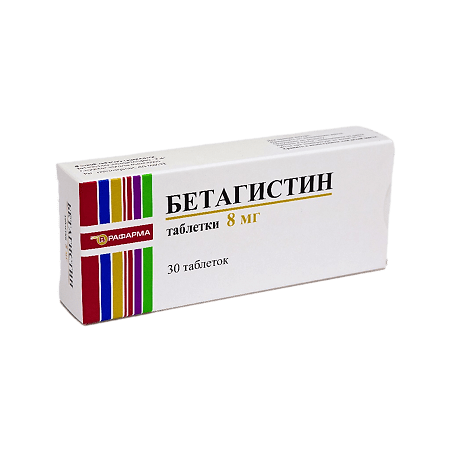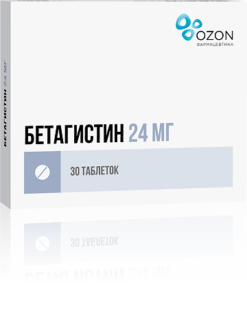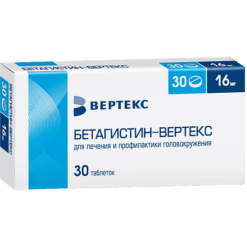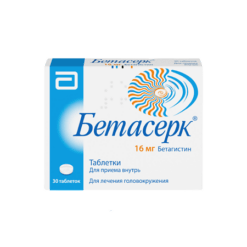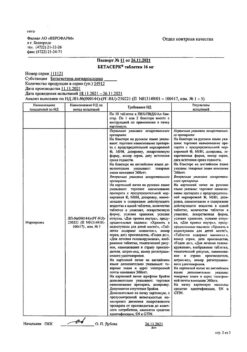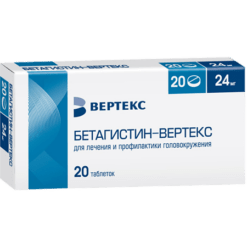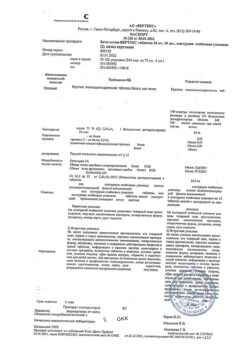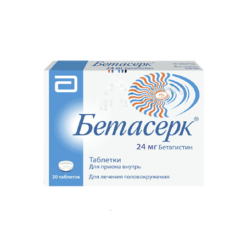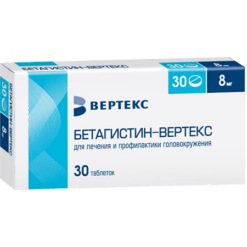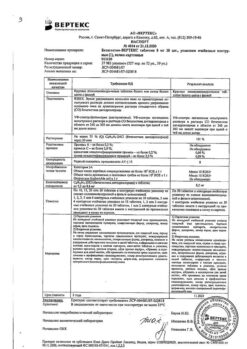No products in the cart.
Betahistine, tablets 8 mg 30 pcs
€5.56 €4.95
Description
Pharmacological group: Histamine drug
ATCode: N07CA01
Pharmacological properties:
Pharmacodynamics. Agonist of H1-histamine receptors of the inner ear vessels and antagonist of H3-histamine receptors of the vestibular nuclei of the CNS. By relaxing the precapillary sphincters of the vessels of the inner ear, it improves blood circulation in the vascular band of the inner ear.
Dose-dependently reduces the generation of action potentials in the neurons of the lateral and medial vestibular nuclei.
Accelerates recovery of vestibular function after unilateral vestibular neurectomy by accelerating and facilitating central vestibular compensation (due to antagonism with H3-histamine receptors).
It alleviates symptoms in Meniere’s syndrome and vestibular vertigo. Stable therapeutic effect occurs after 14 days.
Pharmacokinetics. Absorbed rapidly, binding to plasma proteins is less than 5%. Maximum concentration in plasma is after 3 hours. The elimination half-life is in 3-4 hours.
Metabolized to inactive metabolites: 2-pyridylacetic acid (the main metabolite) and dimethylbetahistine. 85-90% is excreted by the kidneys as 2-pyridylacetic acid within 24 hours. Excretion of betahistine and dimethylbetahistine by the kidneys is insignificant. The intestine excretes only a small portion of betahistine and its metabolites.
Indications
Indications
Treatment of Meniere’s syndrome, characterized by dizziness (accompanied by nausea and vomiting), hearing loss and tinnitus.
Symptomatic treatment of vestibular dizziness (vertigo).
Pharmacological effect
Pharmacological effect
Pharmacological group: Histamine preparation
ATX CODE: N07CA01
Pharmacological properties:
Pharmacodynamics. An agonist of H1-histamine receptors in the vessels of the inner ear and an antagonist of H3-histamine receptors of the vestibular nuclei of the central nervous system. By relaxing the precapillary sphincters of the vessels of the inner ear, it improves blood circulation in the vascular striatum of the inner ear.
Dose-dependently reduces the generation of action potentials in neurons of the lateral and medial vestibular nuclei.
Accelerates the restoration of vestibular function after unilateral vestibular neurectomy, accelerating and facilitating central vestibular compensation (due to antagonism with H3-histamine receptors).
Relieves symptoms of Meniere’s syndrome and vestibular vertigo. A stable therapeutic effect occurs after 14 days.
Pharmacokinetics. Absorbed quickly, binding to plasma proteins is less than 5%. Maximum concentration in blood plasma after 3 hours. The half-life is 3-4 hours.
Metabolized to inactive metabolites: 2-pyridylacetic acid (the main metabolite) and dimethylbetagistine. 85-90% is excreted by the kidneys in the form of 2-pyridylacetic acid within 24 hours. Excretion of betahistine and dimethylbetagistine by the kidneys is insignificant. Only a small part of betahistine and its metabolites is excreted by the intestines.
Special instructions
Special instructions
The therapeutic effect in some cases increases within several months from the start of treatment.
Betahistine does not have a sedative effect and does not affect the ability to drive vehicles or operate machinery.
Active ingredient
Active ingredient
Betahistine
Composition
Composition
active substance: Betahistine dihydrochloride – 8 mg
excipients: microcrystalline cellulose 68 mg, lactose monohydrate
50 mg, crosspovidone 7.0 mg, magnesium stearate 1.4 mg, povidone 4.2 mg, colloidal silicon dioxide (Aerosil) 1.4 mg.
Pregnancy
Pregnancy
There is insufficient data to assess the effects of the drug during pregnancy and lactation. In this regard, use during pregnancy is not recommended. During treatment it is necessary to stop breastfeeding.
Contraindications
Contraindications
Hypersensitivity, pregnancy, lactation, childhood.
Lactase deficiency, lactose intolerance, glucose-galactose malabsorption.
Pheochromocytoma.
With caution:
Peptic ulcer of the stomach or duodenum (history), bronchial asthma. These patients should be monitored regularly during treatment.
Side Effects
Side Effects
Nausea, vomiting, dyspepsia, abdominal pain, bloating, urticaria, itching, rash, angioedema, headache.
Interaction
Interaction
Histamine receptor blockers reduce the effect of betahistine.
Overdose
Overdose
Symptoms: nausea, vomiting, headache, facial flushing, dizziness, tachycardia, decreased blood pressure, bronchospasm; drowsiness (when taken at a dose of up to 640 mg); At a dose of 728 mg, there were reports of seizures.
Treatment: gastric lavage, taking activated carbon, symptomatic therapy.
Storage conditions
Storage conditions
In a dry/protected from light place at a temperature not exceeding 25° C. Keep out of the reach of children.
Shelf life
Shelf life
2 years. Do not use after expiration date.
Manufacturer
Manufacturer
Rapharma JSC, Russia
Additional information
| Shelf life | 2 years. Do not use after the expiration date. |
|---|---|
| Conditions of storage | In a dry/light-protected place at a temperature not exceeding 25° C. Keep out of the reach of children. |
| Manufacturer | Rapharma AO, Russia |
| Medication form | pills |
| Brand | Rapharma AO |
Other forms…
Related products
Buy Betahistine, tablets 8 mg 30 pcs with delivery to USA, UK, Europe and over 120 other countries.

